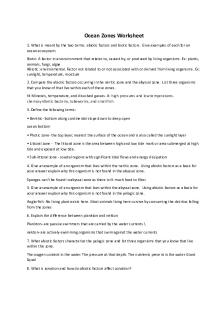Ch 8 Fundamentals - Zones & Personal Space PDF

| Title | Ch 8 Fundamentals - Zones & Personal Space |
|---|---|
| Author | Thalia Velazquez |
| Course | Fundamentals of Nursing |
| Institution | Southeastern Technical College |
| Pages | 2 |
| File Size | 104.3 KB |
| File Type | |
| Total Downloads | 100 |
| Total Views | 158 |
Summary
Download Ch 8 Fundamentals - Zones & Personal Space PDF
Description
Zones/ Personal Space: - personal space: external environment surrounding a person that is regarded as being part of that person - Personal space is the area around a person regarded as part of the person. This area, individualized to each person and to different cultures and ethnic groups, is the area into which others should not intrude during personal interactions. If others do not consider a person’s personal space, that person may become uncomfortable or even angry. When providing nursing care that involves physical contact, you should know the patient’s cultural personal space preferences. - n understanding of personal space and distancing characteristics can enhance the quality of communication (Purnell, 2013). Some aspects of communication zones are dictated through culture, and some are idiosyncratic. Anywhere from 18 in to 4 ft might be optimal distance to sit from a patient during an intake interview. For example, some European Americans and African Americans might require more personal space between two people who are speaking than some people in other cultures (Mediterranean, Hispanic, Asian, Middle Eastern, East Indian) who might be comfortable at a closer distance when speaking (Videbeck, 2014). American conversants tend to place at least 18 in of space between themselves and the person with whom they are talking (Purnell, 2013, p. 216). It is best to take cues from patients, noting whether they are moving backward from you if you are too near or leaning forward to get closer to you. Because many nursing interventions place one in proximity to a patient and entail forced intimacy, be sensitive to how offensive this might be to certain patients who are accustomed to large areas of private space. Develop the habit of seeking the patient’s permission before touching areas within a patient’s private zones. Although most people consider their hands, arms, shoulders, and back within a social zone, increasing levels of privacy are according to (1) mouth and feet; (2) face, neck, and front of body; and (3) genitalia. - The actual physical difference between the nurse and patient during interaction is also important. Proxemics is the study of distance zones between people during communication (Videbeck, 2014). Each person has a sense of how much personal or private space is needed and what distance between people is optimum. Figure 8-3 demonstrates the four communication zones.
Intimate zone: interaction between parents and children or people who desire close personal contact Personal zone: distance when interacting with close friends Social zone: space when interacting with acquaintances such as in a work or social setting Public zone: communication when speaking to an audience or small groups...
Similar Free PDFs

Personal Space
- 1 Pages

Brillouin Zones
- 10 Pages

Chapter 8 (Personal Finance)
- 16 Pages

8 Personal Finance
- 1 Pages

Ch 8- Social Notes - ch 8
- 2 Pages

Ocean zones lab
- 3 Pages

Ocean Zones Worksheet
- 2 Pages

Fundamentals of Management ch 4
- 4 Pages

CH 8/ Lecture 8 ANSWERS
- 13 Pages

Cod numeric personal ( curs 8)
- 2 Pages

Ocean zones lab report
- 3 Pages

Crumple Zones SE
- 17 Pages
Popular Institutions
- Tinajero National High School - Annex
- Politeknik Caltex Riau
- Yokohama City University
- SGT University
- University of Al-Qadisiyah
- Divine Word College of Vigan
- Techniek College Rotterdam
- Universidade de Santiago
- Universiti Teknologi MARA Cawangan Johor Kampus Pasir Gudang
- Poltekkes Kemenkes Yogyakarta
- Baguio City National High School
- Colegio san marcos
- preparatoria uno
- Centro de Bachillerato Tecnológico Industrial y de Servicios No. 107
- Dalian Maritime University
- Quang Trung Secondary School
- Colegio Tecnológico en Informática
- Corporación Regional de Educación Superior
- Grupo CEDVA
- Dar Al Uloom University
- Centro de Estudios Preuniversitarios de la Universidad Nacional de Ingeniería
- 上智大学
- Aakash International School, Nuna Majara
- San Felipe Neri Catholic School
- Kang Chiao International School - New Taipei City
- Misamis Occidental National High School
- Institución Educativa Escuela Normal Juan Ladrilleros
- Kolehiyo ng Pantukan
- Batanes State College
- Instituto Continental
- Sekolah Menengah Kejuruan Kesehatan Kaltara (Tarakan)
- Colegio de La Inmaculada Concepcion - Cebu



